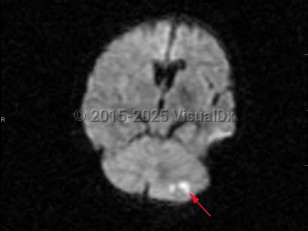- Ischemic cerebellar strokes are predominantly either thrombotic or embolic. Thrombotic strokes are often caused by atherosclerosis, while embolic strokes are commonly cardiogenic (atrial fibrillation), septic, or due to coagulopathy.
- Hemorrhagic strokes can be intraparenchymal, due to hypertension, or secondary to subdural or subarachnoid hemorrhage.
Risk factors for cerebellar strokes are the same as for other cerebrovascular pathologies: hypertension, hyperlipidemia, diabetes, cardioembolic risks such as atrial fibrillation, and tobacco abuse are chief among them. Cerebellar hemorrhages can also be caused by a rupture of vascular malformations; hereditary hemorrhagic telangiectasia (HHT) is a particular risk factor. Rupture of vascular malformations is a more likely cause in children. Other risk factors for cerebellar hemorrhages include sympathomimetic abuse such as cocaine use. Increased urinary sodium is associated with increased risk.
Related topic: drug-induced stroke



